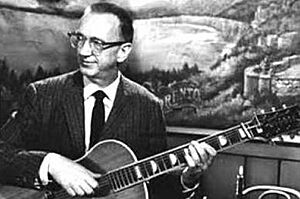George Van Eps facts for kids
Quick facts for kids
George Van Eps
|
|
|---|---|

George Van Eps in 1949
|
|
| Background information | |
| Birth name | George Abel Van Eps |
| Born | August 7, 1913 Plainfield, New Jersey, U.S. |
| Died | November 29, 1998 (aged 85) Newport Beach, California, U.S. |
| Genres | Jazz, swing |
| Occupation(s) | Musician |
| Instruments | Seven-string guitar |
| Years active | 1924–1998 |
| Labels | Euphoria, Capitol, Concord Jazz |
| Associated acts | Freddy Martin, Benny Goodman, Ray Noble, Howard Alden |
George Abel Van Eps (born August 7, 1913 – died November 29, 1998) was an American swing and mainstream jazz guitarist. He was known for his unique playing style and for inventing the seven-string guitar.
Contents
About George Van Eps
Early Life and Musical Family
George Van Eps was born in Plainfield, New Jersey, in the United States. He grew up in a very musical family! His mother, Louise Abel, was a classical pianist. His father, Fred Van Eps, was a famous ragtime banjo player and also worked as a sound engineer. George had three brothers who were also musicians.
George started playing the banjo when he was just eleven years old. But then he heard the amazing guitarist Eddie Lang on the radio. That's when George decided to switch from banjo to guitar. By the time he was thirteen, in 1926, he was already performing on the radio himself!
Becoming a Professional Musician
Through the mid-1930s, George played with many popular musicians and bands. Some of these included Harry Reser, Freddy Martin, Benny Goodman, and Ray Noble. He became a well-known guitarist in the jazz and swing music scenes.
Later, George moved to California. There, he spent most of his career as a studio musician. This means he played guitar for many different projects, like commercials and movie soundtracks. You might have heard his guitar playing without even knowing it!
The Seven-String Guitar and "Lap Piano"
In the 1930s, George Van Eps came up with a really cool idea. He invented a special kind of guitar that had an extra bass string. Most guitars have six strings, but his had seven! This extra string allowed him to play bass notes at the same time as his chords. It was different from how other famous jazz guitarists like Charlie Christian played.
George called his unique way of playing "lap piano." This style was a bit like playing a piano on his lap, because he could play both melody and bass lines at once. His invention and playing style inspired many other jazz guitarists, including Bucky Pizzarelli, John Pizzarelli, and Howard Alden, to also use the seven-string guitar.
Later Career and Legacy
During the 1940s and 1950s, George played in Dixieland jazz groups in Los Angeles. He even appeared in a movie called Pete Kelly's Blues. He also played guitar on Frank Sinatra's famous 1955 album, In the Wee Small Hours.
George Van Eps continued to play guitar into his eighties. His music career lasted for more than sixty years! He passed away from pneumonia in Newport Beach, California, on November 29, 1998, when he was 85 years old.
Music Albums
George Van Eps released many albums as a band leader and also played on albums for other artists.
As a Leader or Co-Leader
- 1949 Jump Presents George Van Eps
- 1957 Mellow Guitar
- 1966 My Guitar
- 1967 George Van Eps' Seven-String Guitar
- 1967 Soliloquy
- 1991 Thirteen Strings with Howard Alden
- 1992 Hand-Crafted Swing with Howard Alden
- 1993 Seven & Seven with Howard Alden
- 1994 Keepin' Time with Howard Alden
- 1994 Legends with Johnny Smith
As a Sideman (playing for other artists)
- 1947 The Voice of Frank Sinatra by Frank Sinatra
- 1955 In the Wee Small Hours by Frank Sinatra
- 1960 Bing & Satchmo by Louis Armstrong and Bing Crosby
- 1987 Sing, Sing, Sing by Benny Goodman
- 1994 It's Magic by Doris Day
- 1996 The Mel Tormé Collection by Mel Tormé

